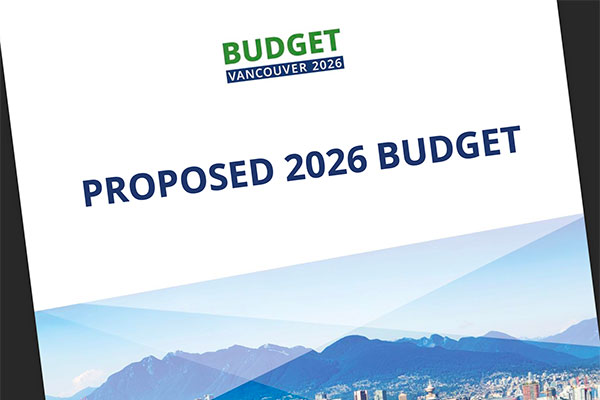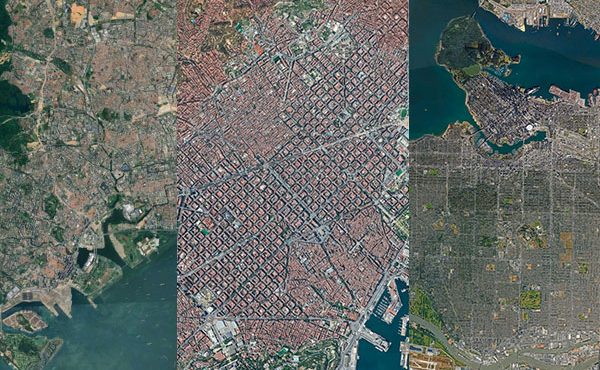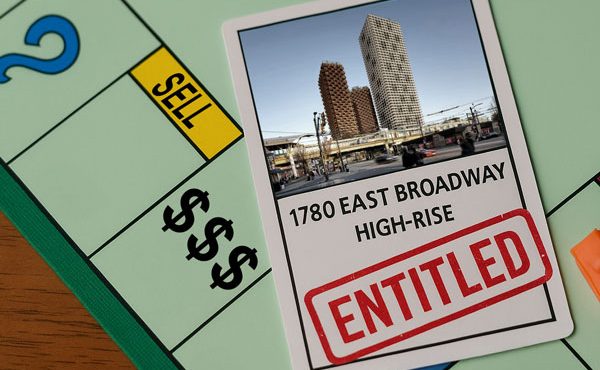
Vancouver’s proposed 2026 Budget arrives with a promise that feels, at first glance, like a reprieve: a 0% property tax increase in a year when almost everything in the city seems to cost more. But peel back the polished surface and a more complicated, less comfortable story emerges—one of a city trying to hold itself together while cutting the very muscles it needs to stand upright.
This is a budget that balances today by borrowing capacity from tomorrow, a budget that looks calm on the surface but conceals a strong current beneath.
The zero‑increase directive was not a conclusion the staff reached through analysis; it was a political instruction from Council. The city’s own budget survey showed that residents were willing to accept a modest increase—indeed, the most preferred option was a five percent rise to maintain services.
What the public asked for was stability. What Council delivered was the appearance of stability. The difference matters. One is anchored in capacity; the other in optics.
This tension crystallized during the budget hearings when ABC Council. Brian Montague cast doubt on the validity of the City’s own annual budget survey—a survey that clearly showed residents did not ask for a tax freeze and were willing to support modest increases to maintain services. By questioning the method rather than engaging the message, Montague revealed a deeper pattern: when public input contradicts political direction, the impulse is not to adjust course, but to discredit the compass.
In that moment, the alignment between the survey data, the budget analysis, and the testimony inside council chambers came into full view. All three pointed to the same conclusion, and yet the elected response was to cast doubt on the mirror rather than the image reflected within it.
Because the 0% increase was mandated, staff were required to find $120 million in new revenue and expenditure reductions. The document describes this as a “back‑to‑basics” effort: reorganizing management structures, consolidating overlapping functions, streamlining support systems, and discontinuing work that does not contribute directly to front‑line service delivery.
The language is tidy and managerial, but beneath its neutral tone lies a set of quiet contractions.
Nowhere does the budget list which services will be scaled back, which initiatives will be discontinued, or what the consequences will be for planning, climate work, cultural life, neighbourhood supports, or long-term strategy. This omission became painfully clear during the public hearings, where residents confronted councillors with the human-scale consequences of such ambiguity. As speaker after speaker reminded them, a budget that hides its cuts makes informed decision-making impossible.
Yet some impacts are easy to infer. Planning, Urban Design, and Sustainability is reduced by fourteen percent. Arts, Culture, and Community Services shrinks by twelve percent. Real Estate, Environmen,t and Facilities Management drops by thirteen. Corporate support functions tighten across the board. These cuts coincide with simultaneous increases to police and fire services, ten percent and six percent, respectively.
What emerges is a shift in civic posture: a city investing more heavily in reacting to problems while investing less in preventing them.
All of this unfolds alongside a striking contradiction embedded in the budget itself. The City clearly recognizes that the municipal funding model is no longer fit for purpose. Property taxes, once sufficient for a narrower scope of responsibilities, cannot keep up with the civic load now placed on municipalities—from housing to mental health to climate resilience. The budget states plainly that “growth pays for growth” no longer works.
And yet Council proceeds with a budget that relies even more heavily on the same outdated tools, freezing the one flexible revenue mechanism it controls while expanding capital investments and drawing increasingly on internal transfers to make the numbers balance.
This contradiction becomes sharper when looking at the City’s capital program. Vancouver plans to spend $894 million in 2026, its largest ever capital year, powering ahead with complex, multi-year projects such as the renewal of the PNE Amphitheatre, seismic upgrades to the Cambie Bridge, and the design of a new Vancouver Aquatic Centre. Yet, the very departments responsible for planning, coordinating, and stewarding this infrastructure are being reduced.
Building more while thinking less is not a strategy—it is a warning sign.
Debt figures tell a similar story. Net debt per capita has doubled since 2010, even after adjusting for inflation. Debt servicing levels approach benchmark limits. While the City retains a AAA credit rating, the rating reflects past performance rather than future resilience. Credit agencies do not yet measure what it means to refill potholes while hollowing out the transportation department, or to construct new civic buildings while shrinking the teams that maintain and operate them.
Vancouver’s infrastructure is expanding at the same time its institutional capacity is contracting, and no rating formula captures that tension.
The budget also reveals a quieter shift in costs. While property taxes remain frozen, utility fees rise by 4.2 percent. The increase is largely due to Metro Vancouver pass-throughs, but for households, the distinction is irrelevant. Budgets are experienced as a single lived reality, not a series of technical categories. Freezing one bill while allowing another to rise is less a gesture of affordability than a shifting of pockets.
Perhaps the most striking element in the budget is the mismatch between what the City says and what it does.
The document extensively discusses livability, resilience, sustainability, and the importance of planning for long-term needs. Yet the investments that actually sustain those ideals—planning capacity, cultural networks, community support, and environmental stewardship—are precisely where the budget cuts are made.
Livability is not sustained through amphitheatres and aquatic centres alone. Testimony at City Hall made this point sharper than any line item could. Parents spoke of community centres as a second home, seniors described the slow erosion of accessible spaces, and climate professionals warned that cuts to sustainability staff would undermine an entire economic sector. These public voices are lanterns casting light onto the parts of the budget otherwise left in shadow, revealing where its weaknesses truly lie.
True livability depends on the slow, often invisible work of building systems and services that allow people and communities to thrive.
The 2026 Budget appears to offer stability on its surface, but it is a stability achieved through narrowing rather than strengthening. It keeps the ship upright by quietly taking on water in compartments the public does not see. A city cannot reduce its long-range thinking without paying for it later.
If Vancouver is to meet the challenges it faces—housing affordability, climate adaptation, aging infrastructure, social cohesion, and growth—it will require budgets grounded in structural honesty.
Municipalities need new revenue tools. They need predictable funding. They need to invest in planning, culture, and community infrastructure with the same seriousness as they invest in physical construction. And they need to resist the temptation to deliver political comfort today at the cost of tomorrow’s resilience.
A different path is possible. One where budgets reflect the true cost of caring for a city rather than the cost of appearing careful. One where the City invests in the quiet, essential systems that hold urban life together. One where we recognize that affordability and resilience are not achieved through freezes or cuts, but through alignment between values and resources.
Sadly, the current leadership continues to prioritize political optics over long-term planning, making short-term messaging take precedence over the long-term financial and operational decisions the city needs to remain functional and resilient. This leaves the city without the stable footing needed to navigate future challenges.
And given the widespread expectation that ABC councillors are unlikely to change their votes in response to public opposition, it seems that, until leadership changes, Vancouver’s budgets will continue to operate under mounting stress.
If the hearings made anything clear, it is that democratic legitimacy is not a background feature of budgeting—it is the ground on which the entire structure rests.
When hundreds of residents, independent surveys, and the City’s own financial logic all point to the need for sustainable investment, dismissing those signals does not make them go away. It simply weakens the civic foundation they were meant to strengthen. Vancouver’s future depends on a budgeting process that listens when the public speaks, responds when evidence is offered, and recognizes that democracy is not an obstacle to fiscal governance but its only durable anchor.
***
One can access a PDF of the City of Vancouver’s Proposed 2026 Budget directly here.
**
Other related articles:
- The Slow Emergency
- The Slow Emergency, Part II: The Emergency Escalates
- Trifecta of Control: Stealth. Speed. Compexity
- Entitled to Flip
- When Local Planning Becomes Provincial Command
- The Coriolis Effect, Part I: Planning by Spreadsheet
- The Coriolis Effect, Part II: Beyond the Spreadsheet
- The Coriolis Effect, Part III: Reclaiming the Planner’s Toolkit
- The Coriolis Effect, Part IV: When Viability Becomes Destiny
- When Care Becomes Control
- The Broadway Plan Blues
- Learning from Moses
*
Erick Villagomez is the Editor-in-Chief at Spacing Vancouver and teaches at UBC’s School of Community and Regional Planning. He is also the author of The Laws of Settlements: 54 Laws Underlying Settlements Across Scale and Culture.





One comment
On one hand, I agree that the City needs to spend more on infrastructure to make up for years of underspending. I also agree that all residents have to pay for growth, not just the new residents. So taxes probably have to go up. I think what this council is trying to do is change the mindset among staff from one of “unlimited resources” to one of “what is essential and what can we do without in times of austerity” (and by the way, I think austerity is here to stay in every city in the world). This is a painful mindset shift because people don’t want to think about thrift, but going to this extreme may be the only way to make it happen.
One last point, you cite a study that says most residents would be OK with a 5% tax increase. This doesn’t sound like much, but it’s a doubling of property tax in 14 years. That is a much more stark picture of what 5% really is. It’s massive. Property taxes are already $650 per month for a modest East Van house. Think about how that interacts with affordability. Another way the question should be asked of people is “would you pay $100 more per month to have certain luxuries like a climate change department, more libraries, and a 50m pool instead of 25m at the VAC?” A wealthy resident would probably be fine with it, but to a lower income person that’s a lot of money and they would probably say no. I’m looking at this through the lens of housing affordability.